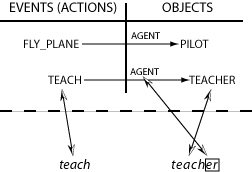| 8.1 | Derivational morphology |
| 8.2 | Foregrounding and backgrounding |
| 8.3 | Active and passive voice |
| 8.4 | More verb derivation |
8.1 Derivational morphology
Early on in their creation of words for the categories of things, attributes, states, and events around them, the Grammies realized that there were often pairs of concepts that were associated by a particular abstract relation. For example, given a scalar attribute like the one designated by the word wide, there is the happen event involving a change of state in some object in the direction of that attribute and also the do_to event involving an agent who causes such a change of state. These three related concepts are exemplified in the following English sentences.
- wide road
- The road widens at this point.
- The workers are widening the road.
Note the English uses, the same verb, widen, for both the happen and the do_to events, intransitive widen for the first, transitive widen for the second.
Further, the Grammies saw that each of these abstract relations applied to many pairs of concepts. For example, the same relations that relate to the meaning of wide to the meaning of intransitive widen relate meaning of dark to the meaning of darken and the meaning of dead to the meaning of die.
We have seen several examples of how languages capitalize on generalizations such as this to save Speakers and Learners the trouble of learning separate words for each of the concepts they might want to refer to. For example, we saw how adjective + noun phrases avoided the use of a separate word for each combination of attribute dimension value and thing category. With the word red, a speaker could say red apple, red pear, red rock, and red sky, instead of learning a separate word for each of these. Because red can combined with any noun whose meaning is compatible with redness, the pattern red + noun is a productive one in English. In fact the pattern adjective + noun is a productive one, as we've seen.
The Grammies saw that similar advantages could be gained by being systematic about how they created new words from old words on the basis of the abstract relations they'd discovered. That is, they realized that this was another place where language could make things easier for Learners and Speakers by being productive. For each of the abstract relations, they needed a morpheme to combine with a word, or a lexical root, to form the new word. This process is called derivation.
Derivation is common in the modern languages of the world. For example, many of them have productive ways of relating adjectives to change-of-state verbs. In English the verb is derived from the adjective by adding the suffix -en to the adjective. Examples are weaken, shorten, lighten, blacken, sharpen, soften, and loosen. Notice that this process is only somewhat productive; it doesn't apply to long (verb: lengthen), big (verb: grow), or thin (verb: thin). If we learned a new adjective, say, zub, we might not feel completely confident in making into a verb zubben. In some other languages, such as Amharic, it is usually the adjective that is derived from the verb. For example from the verb root drk' meaning 'get dry', the adjective dIrk' 'dry' is derived.
Another possibility, common in English, is for the two forms to be identical. For example, as we have seen, widen can describe a change in the width of something or a causing of such a change. In the last chapter, we treated these two meanings as two different syntax-semantics mappings. In any case, we have no basis for seeing one of them as derived from the other. Another example is provided by the relatively productive pattern in English by which a noun for an instrument can also be used as a verb designating the use of such an instrument. Examples are hammer, saw, chisel, pin, and nail. Though historically the nouns came first, again we can treat the nouns and verbs simply as related meanings of a single word.
When there is derivational morphology, a Speaker or Hearer of the language must know not only what the grammatical morpheme is and how it combines with the lexical morpheme but also the grammatical convention for how the meaning of the more complex word is derived from the meanings of the two components. Let's consider another English example, the addition of -er to a verb to produce an noun. The compositional convention would say something like this: the meaning of the complex word is a person who acts (routinely or one occasion) as the agent of the category of event (action) which the verb designates. Thus a teacher is a person who acts as the agent of a teaching event. The diagram below illustrates the relationships.

Like the derivation of verbs from adjectives (or adjectives from verbs) the agent noun derivation of one sort or another is quite common in the world's languages. But languages also different considerably in how much they make use of derivational morphology. Languages with rich morphology may allow a very wide range of new words to be derived from a single lexical root. In a sense these languages are making generalization that are not made in other languages, which must rely on separate, unrelated words or whole phrases to convey the different meanings. In the next I'll describe some of the possibilities for derivational morphology on Lingala verbs. Like other languages in the Bantu family, Lingala allows a number of different verbs to be derived from a single verb root.
